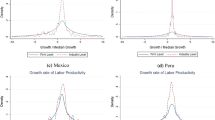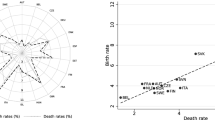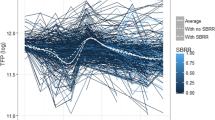Abstract
In a healthy economy, plant turnover increases aggregate productivity because efficient producers are more likely to survive. Given high entry and exit rates and the potential importance of turnover in accounting for aggregate productivity, in this paper we examine the determinants of plant exits and then examine how exits and other forms of output reallocation contribute to aggregate productivity. Using a unique plant-level longitudinal data set for Colombia for the period 1982–98, we examine the role of productivity and demand as well as input costs in determining plant exits. Moreover, given the important structural reforms introduced in Colombia during the early 1990s, we explore whether and how plant survival changed after these reforms. Our data permit measurement of plant-level quantities and prices, which allows us to decompose productivity and demand shocks and, in turn, to estimate the effects of these fundamentals on plant exit. We find that higher productivity, higher demand, and lower input prices decrease the probability of plant exit. We also find that the importance of physical efficiency and costs in determining exits increases after the introduction of structural reforms. Finally, a decomposition of aggregate productivity suggests that reallocation through entry and exit is important in accounting for the increase in aggregate productivity after the introduction of structural reforms.
Similar content being viewed by others
Notes
Because many of the variables we use in our analysis here were also used in Eslava and others (2004), the data description in this section closely follows that paper. In particular, Eslava and others (2004) describes in detail the construction of the capital stock, hours of work, output and materials prices, and total factor productivity (TFP) and demand shock measures. We include an abbreviated version of the discussion on the database and variable construction in this paper. However, the focus of Eslava and others (2004) was on the evolution of TFP and demand shocks over the 1980s and 1990s in Colombia and the contribution of overall reallocation to aggregate productivity. By contrast, the focus of this paper is on the determinants of plant exits—including TFP and demand shocks—and the changing importance of these determinants after the market reforms of the 1990s. In addition, we examine here the impact of reallocation through exits on aggregate productivity.
Foster, Haltiwanger, and Syverson (2005) use plant-level physical quantity data for selected U.S. detailed product classes to analyze the determinants of market selection in the United States using a similar approach. Their findings in broad terms are consistent with the findings we report here. However, in contrast to the approach taken here, there is no comparable set of market reforms in the United States to investigate the interaction between market reforms and market selection.
See Eslava and others (2004) for a more extensive discussion of the Colombian reforms.
Note that the Colombian electoral system at the time ruled out election for more than one term.
It may be interesting to develop measures of reforms that permit understanding of how the reforms may have affected different types of firms differently. One way to proceed would be to note that the trade reform affected different sectors differently, because changes in effective tariff rates vary across sectors. In addition, it is likely that some reforms (for example, financial reforms) affected small and young firms differently than large and mature firms. In this paper, we take a more parsimonious approach, which focuses on the time-series variation of the reforms, and leave the construction of specific reform indices that vary by sector and other observable factors for future work.
Caution needs to be used in interpreting the aggregate (mean) relative prices in this context because the relative price at the micro level is the log difference between the plant-level price and the log of the aggregate producer price index. See Eslava and others (2004) for additional discussion on this issue.
However, in contrast to the demand function estimation in Eslava and others (2004), which is done at the aggregate level, here we allow the demand function to vary by three-digit sector.
Sargan tests suggest these are valid instruments, including energy and materials prices, which are unlikely to be affected by buyers’ market power in the Colombian context. See Eslava and others (2004) for further details on the instruments.
It is still of interest to explore further the possibility of estimating sector factor elasticities using our IV approach. This would require finding additional instruments (for example, demand shifters) that vary across plants within the same sector. We leave the construction of such additional demand shifters for future work.
The demand estimation and demand shocks here differ in notable ways from Eslava and others (2004). First, we estimate the direct demand function rather than the inverse demand function here. Second, we estimate the demand function at the three-digit level here whereas in the earlier paper we estimated a common demand function for the manufacturing sector.
The sample size is larger in this table than in Table 2 because the estimations in that table require information on the instruments used for estimating the production function, whereas demand estimations require only information on output prices, physical output, and TFP estimates.
This means that our focus here is on within-sector reallocation rather than on between-sector reallocation, for sectors defined at the three-digit level. For measurement and conceptual reasons, comparisons of TFP across sectors (in levels) are more problematic to interpret. Focusing on within-sector allocation permits us to emphasize the degree to which market reforms have led to an improved allocation of activity across businesses owing to higher competition.
An advantage of this cross-sectional method, over methods that decompose changes in productivity over time, is that cross-sectional differences in productivity are more persistent and less dominated by measurement error or transitory shocks.
References
Ericson, Richard, and Ariel Pakes, 1995, “Markov-Perfect Industry Dynamics: A Framework for Empirical Work,” Review of Economic Studies, Vol. 62 (January), pp. 53–82.
Eslava, Marcela, John Haltiwanger, Adriana Kugler, and Maurice Kugler, 2004, “The Effects of Structural Reforms on Productivity and Profitability Enhancing Reallocation: Evidence from Colombia,” Journal of Development Economics, Vol. 75 (December), pp. 333–71.
—, 2005, “Factor Adjustments After Deregulation: Panel Evidence from Colombian Plants,” NBER Working Paper No. 11656 (Cambridge, Massachusetts: National Bureau of Economic Research).
Foster, Lucia, John Haltiwanger, and Chad Syverson, 2005, “Reallocation, Firm Turnover, and Efficiency: Selection on Productivity or Profitability?” NBER Working Paper No. 11555 (Cambridge, Massachusetts: National Bureau of Economic Research).
Hopenhayn, Hugo, 1992, “Entry, Exit, and Firm Dynamics in Long Run Equilibrium,” Econometrica, Vol. 60 (September), pp. 1127–50.
Jovanovic, Boyan, 1982, “Selection and the Evolution of Industry,” Econometrica, Vol. 50 (May), pp. 649–70.
Kugler, Adriana, 1999, “The Impact of Firing Costs on Turnover and Unemployment: Evidence from the Colombian Labour Market Reform,” International Tax and Public Finance Journal, Vol. 6 (August), pp. 389–410.
—, 2005, “Wage-Shifting Effects of Severance Payments Savings Accounts in Colombia,” Journal of Public Economics, Vol. 89 (February), pp. 487–500.
—, and Maurice Kugler, 2003, “The Labour Market Effects of Payroll Taxes in a Middle-Income Country: Evidence from Colombia,” CEPR Discussion Paper No. 4046 (London: Centre for Economic Policy Research).
Kugler, Maurice, forthcoming, “Spillovers from Foreign Direct Investment: Within or Between Industries?” Journal of Development Economics.
Lora, Eduardo, 2001, “Structural Reforms in Latin America: What Has Been Reformed and How to Measure It,” Research Department Working Paper No. 466 (Washington: Inter-American Development Bank).
Melitz, Marc, 2003, “The Impact of Trade on Intra-Industry Reallocations and Aggregate Industry Productivity,” Econometrica, Vol. 71 (November), pp. 1695–725.
Olley, G. Steven, and Ariel Pakes, 1996, “The Dynamics of Productivity in the Telecommunications Equipment Industry,” Econometrica, Vol. 64 (November), pp. 1263–97.
Shea, John, 1993, “The Input-Output Approach to Instrument Selection,” Journal of Business and Economic Statistics, Vol. 11, No. 2, pp. 145–55.
—, 1997, “Instrument Relevance in Multivariate Linear Models: A Simple Measure,” Review of Economics and Statistics, Vol. 79, No. 2, pp. 348–52.
Syverson, Chad, 2004, “Market Structure and Productivity: A Concrete Example,” Journal of Political Economy, Vol. 112 (December), pp. 1181–222.
Author information
Authors and Affiliations
Additional information
The authors thank Juanita Gonzalez, Luis Eduardo Quintero, and Diana Hincapie for superb research assistance. Support for this research was provided by the Tinker Foundation, and a GEAR grant from the University of Houston.




